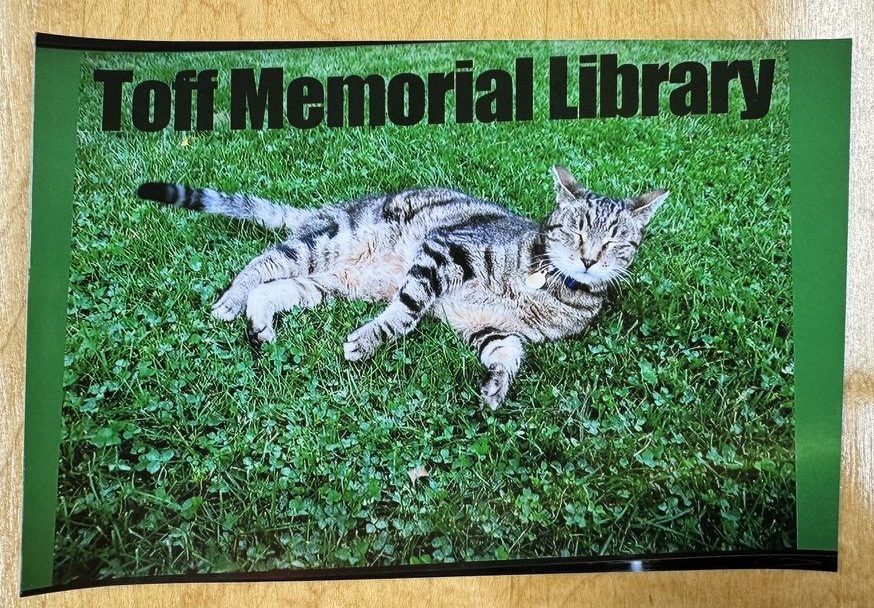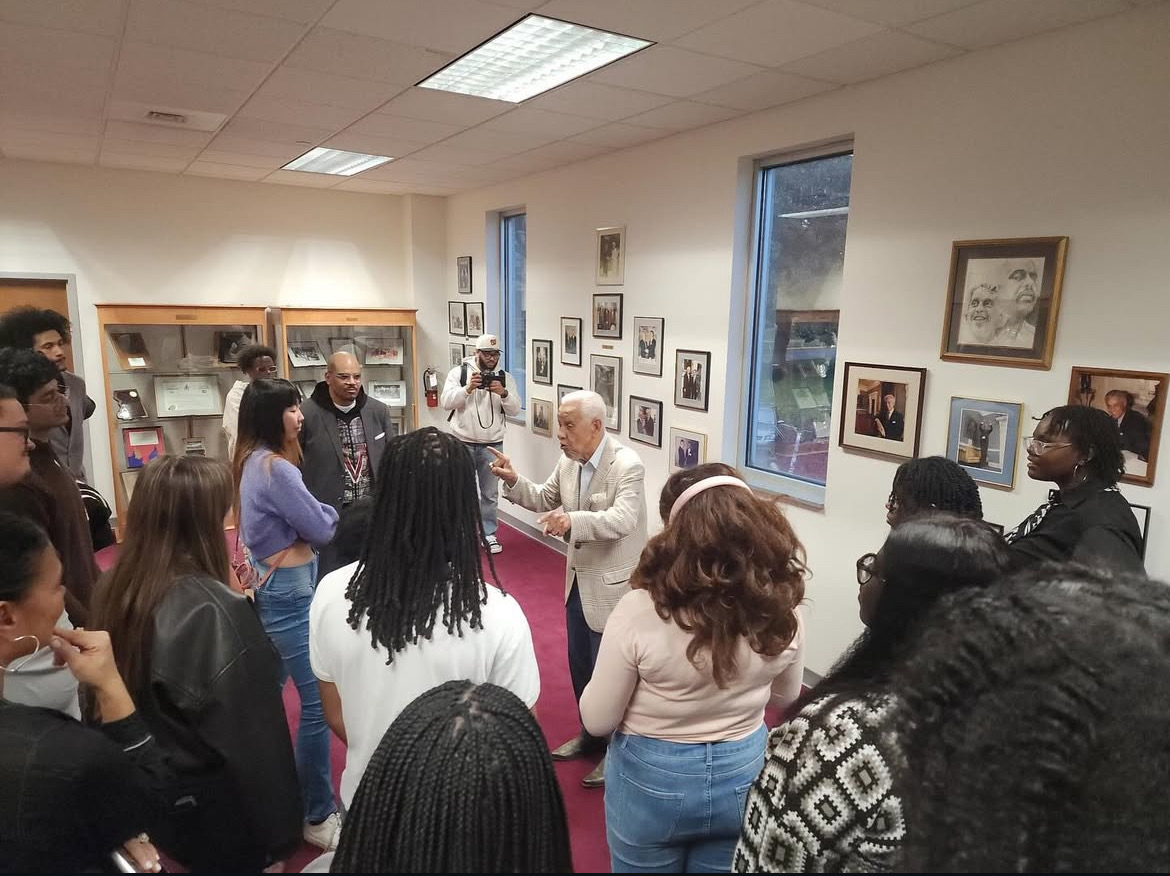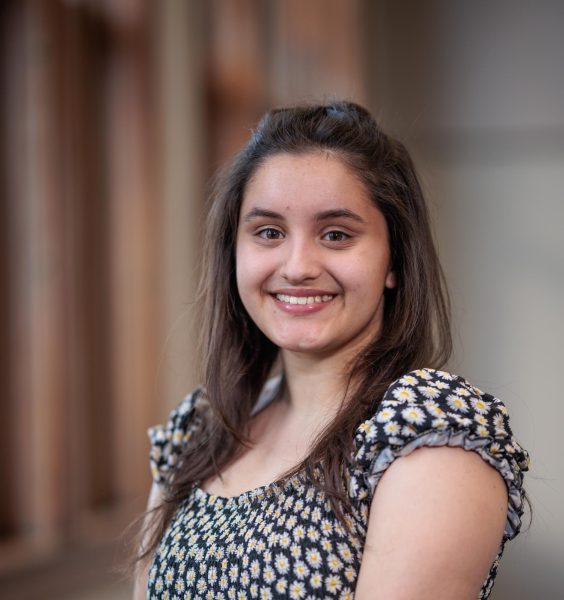On Sunday Jan. 28 from 11 a.m. to 1 p.m. members of the Dacie Moses House hosted their annual celebration of Dacie Moses’s birthday in Anderson Hall.
Entering the hall, the feast displayed in the center of the room — an unusual sight amidst the STEM classrooms and study nooks — commanded attention. The spread consisted of a variety of baked goods, from vegan pretzel bites to mini-quiches, along with fresh berries and vegetables. The serving area, a series of folding tables running down the center of the atrium with blue star-shaped balloons popping up along its length, was brimming with goodies, leaving platters of cookies and muffins to hang precariously over the edge as more and more food was brought in by attendees. A poster with large lettering proclaiming “Happy Birthday Dacie” became covered in guests’ signatures and similar birthday wishes as the event progressed. Accordion music wafted above it all. This was not merely a brunch, but a celebration of a life well lived.
The life in question was that of Dacie Moses (1883-1981). Moses fostered a welcoming environment for Carleton students at her house from 1947 until she passed away, leaving her house to the college in her will. Sharon Jackson, coordinator of the event and current Dacie Moses House and Program Coordinator, shared how Moses fostered a “homelike atmosphere — not a dorm, study hall, dining hall or classroom.” This unique environment was a place where students could, as Jackson describes, “just go and hang out, grab a cookie before class or make dinner when feeling homesick.” Jackson identified how the Dacie Moses House has always been there “for students that needed to feel like they belonged.” Open daily 52 weeks of the year from 6 a.m. to midnight, there is “truly no other space like that on campus,” remarked Jackson. “In fact, such a house is really unique to college campuses in general. As far as we know, there is no other place like this.”
Julia Uleberg, former house manager of the Dacie Moses House, has interviewed alumni and others connected to Dacie Moses through the Story Project. Uleberg reported that in these conversations, people spoke of “being held by the house,” and feeling “that the house still had [Moses’s] spirit, her kindness, her generosity.”
As the previous house manager for 32 ½ years, and now as a member of the Dacie Moses committee, Uleberg interpreted her role as a “keeper of the legacy” and “practitioner of hospitality and generosity.” This legacy is not just of the house, but of the woman who made it a home. “Can you imagine: before you die you give your house to Carleton and all these years later people remember not just the house, they remember your story,” said Uleberg. “They remember this grandmother who welcomed students into her house. This grandmother who listened very carefully to students. This grandmother who created a place for students who didn’t feel like they had a home at Carleton.”
Following a brief statement given by Uleberg, the Knightingales (the Gales), Carleton’s oldest female a capella group, began their performance. Opening to thunderous applause, their singing filled the entire Anderson atrium and captured the attention of the audience, silencing any lingering chatter. The Carleton Singing Knights (the Knights) then performed their traditional opening song as well as a few others from their repertoire. They concluded their show with both acapella groups joining together to sing “Happy Birthday.”
The Gales and Knights have a special, historic connection with the Dacie Moses house. Rounce Moses, the son of Dacie Moses, was a member of the Northfield Male Chorus. It was this chorus that initially began practicing at the Dacie Moses house, and continued the tradition for 25 years from 1936 to 1961. From their inception, the Knights and the Gales have also used the Dacie Moses House as a place to practice. Jackson described the relationship, saying, “A capella groups have always practiced in the cookie house, [they’re] always a part of our community.”
During the performance, attendance was at its highest. Students sat on the floor, leaned against pillars and walls and crammed in any space they could fit, listening with rapt attention. “For a brunch normally in the house they can fit 100 to 125 people, which is really tight for those quarters,” said Jackson, commenting on the high turnout for the event. “Close to 200 people here today, almost double what we normally get.”
Sophie Greene ’14, a resident of the Dacie Moses house in 2012, was one of many Dacie Moses committee members in attendance. The Dacie Moses committee is a group of volunteers who come together to support the house and its mission. This committee was formed when Moses fell ill, and after her passing, they kept the house going. It wasn’t until 2006, over two decades after Moses left her house to Carleton, that the position of Dacie Moses House Coordinator was established. Before then, the house was run by volunteers. Uleberg worked without pay for 20 years before Carleton started paying her and giving her a small budget. Presently, Carleton is a strong supporter of the Dacie Moses House, particularly the Dean of Students: “Livingston really supports the cookie house,” said Jackson.
Greene came down from the Twin Cities to contribute pastries and her presence to the event, happy to further Moses’s legacy and see “the spirit that [Moses] cared about being carried forward.” For Greene, the Dacie Moses House was a huge part of her Carleton experience as it “really impacted the way I was able to move through this school.”
Going forward, the Dacie Moses house is undergoing radical change; however, the spirit remains the same. Currently, the Dacie Moses house is only metaphorical as members of the house do their best to “keep the Dacie Moses feeling going in a totally different sense,” said Jackson. While renovations are underway, brunches are being hosted in Cassat. Jackson shared her excitement for the future of the Dacie Moses House: “In a year from now, it will be fantastic.”













Glenn Lee ‘78 • Feb 6, 2024 at 6:24 pm
Thank you for the lovely write-up! The accordion music was mine and the fiddle was played by Tim Vick. We started playing music together in the House around 1976.